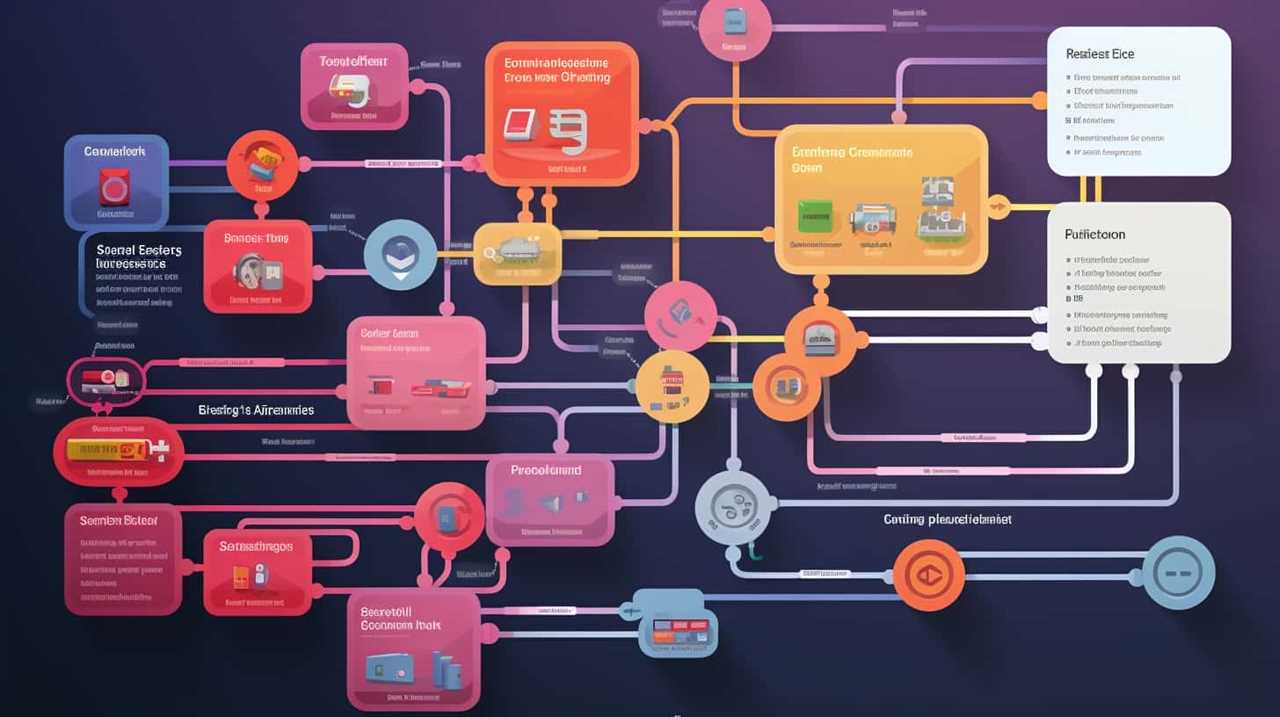Struggling to enhance your ecommerce site’s search engine optimization? Search no more.
We’ve compiled 11 essential keyword tips to help you improve your SEO game.
From understanding the importance of keywords to leveraging user-generated content, we’ve got you covered.
Get ready to boost your rankings and drive more organic traffic to your online store.

Let’s dive in and master ecommerce SEO optimization together.
Key Takeaways
- Keyword density is important for optimizing ecommerce SEO and maintaining relevance.
- Thorough keyword research, including competitor analysis and long-tail keyword targeting, is crucial for effective ecommerce SEO.
- Long-tail keywords attract highly relevant traffic, increase conversions, and provide a better user experience.
- Targeting specific customer needs and personalizing the customer experience through long-tail keywords improves overall user engagement and conversion rates.
Understanding the Importance of Keywords
Keywords play a crucial role in optimizing ecommerce SEO. Understanding the importance of keyword density is essential for achieving success in online searches. Keyword density refers to the number of times a keyword appears on a webpage in relation to the total word count. It helps search engines understand the relevance and topic of a webpage.
Maintaining an optimal keyword density ensures that your content is well-optimized and targeted towards your desired audience. Another aspect to consider is optimizing for voice search. With the increasing popularity of voice assistants like Siri and Alexa, it’s crucial to adapt your SEO strategy to accommodate voice commands. This involves using conversational keywords and long-tail phrases that people are likely to use when speaking.
Conducting Thorough Keyword Research
To conduct thorough keyword research, we continue our discussion on the importance of understanding keyword density and optimizing for voice search. Keyword selection is a critical step in the process, as it determines the relevance and visibility of our ecommerce website.

Here are two key strategies to consider when conducting keyword research:
- Competitor analysis: Analyzing the keywords used by our top competitors can provide valuable insights into their SEO strategies. By identifying the keywords they’re targeting and their ranking positions, we can uncover potential opportunities and gain a competitive advantage.
- Long-tail keyword research: Long-tail keywords are longer and more specific keyword phrases that have less competition. By utilizing long-tail keywords, we can target a niche audience, increase our chances of ranking higher in search results, and attract more qualified traffic to our ecommerce site.
By implementing these strategies, we can optimize our keyword selection and enhance our ecommerce SEO efforts.
Moving forward, let’s explore the benefits and strategies of utilizing long-tail keywords for ecommerce.
Utilizing Long-Tail Keywords for Ecommerce
When it comes to optimizing our ecommerce website, utilizing long-tail keywords can provide significant benefits.

By targeting specific customer needs with longer, more specific keyword phrases, we can attract highly relevant traffic and increase our chances of converting those visitors into customers.
Studies have shown that long-tail keywords have a higher conversion rate compared to generic or broad keywords, making them a valuable tool in our SEO strategy.
Benefits of Long-Tail Keywords
We frequently utilize long-tail keywords for ecommerce to maximize their benefits. When it comes to increasing search visibility and improving organic traffic, long-tail keywords play a crucial role. Here are some key advantages of using long-tail keywords for your ecommerce website:
- Less Competition: Long-tail keywords are more specific and targeted, which means there’s less competition for these keywords compared to more generic ones.
- Higher Conversion Rate: Since long-tail keywords target specific user intent, they tend to attract highly relevant traffic, resulting in a higher conversion rate.
- Improved Relevance: Long-tail keywords allow you to optimize your content around specific product attributes, features, or niche topics, making it more relevant to your target audience.
- Better User Experience: By using long-tail keywords, you can provide users with more precise and accurate search results, enhancing their overall experience on your website.
Targeting Specific Customer Needs
Our ecommerce SEO strategy targets the specific needs of our customers by utilizing long-tail keywords. By targeting niche markets, we can personalize the customer experience and provide them with exactly what they’re looking for.

Long-tail keywords allow us to focus on specific customer needs and preferences, enabling us to create highly relevant and tailored content. This approach not only increases our chances of attracting the right customers but also improves the overall user experience on our website.
Increasing Conversion Rates
To boost conversion rates, we leverage the power of long-tail keywords, tailoring our content to meet the specific needs and preferences of our target audience. When it comes to increasing customer engagement and improving website navigation, long-tail keywords play a crucial role. Here’s how we do it:
- Enhancing customer engagement
- Creating informative and engaging product descriptions that address the pain points of our customers.
- Incorporating long-tail keywords in our blog posts and articles to provide valuable information to our audience.
- Improving website navigation
- Utilizing long-tail keywords in our website’s menu and navigation categories to make it easier for our customers to find what they’re looking for.
- Optimizing our search bar with long-tail keywords to provide accurate and relevant search results.
Incorporating Keywords in Title Tags and Meta Descriptions
When optimizing ecommerce SEO, it’s important to incorporate relevant keywords in title tags and meta descriptions. These elements play a crucial role in helping search engines understand the content of your web pages.
Title tags should include primary keywords that accurately describe the page’s content and entice users to click. Meta descriptions, on the other hand, provide a brief summary of the page and should also incorporate relevant keywords to improve visibility in search results.

By strategically placing keywords in both the title tags and meta descriptions, you can increase the chances of your pages ranking higher in search engine results pages (SERPs).
Remember to keep the titles and descriptions concise, compelling, and relevant to improve user experience and drive organic traffic to your ecommerce site.
Optimizing Product Descriptions With Targeted Keywords
We optimize product descriptions by incorporating targeted keywords to enhance search engine visibility and attract potential customers. To effectively optimize product descriptions, we focus on targeting buyer intent and optimizing product titles.
Here are two key strategies to consider:

- Keyword research: Conduct thorough keyword research to identify relevant terms and phrases that align with your target audience’s search intent. Use tools like Google Keyword Planner or SEMrush to find high-volume and low-competition keywords.
- Strategic placement: Once you have identified your target keywords, strategically place them throughout your product descriptions. Incorporate keywords in the title, headings, and within the body of the description. However, ensure that the keywords are used naturally and don’t compromise the readability and flow of the content.
Enhancing Category Pages With Relevant Keywords
In order to further optimize our ecommerce SEO efforts, we can enhance our category pages by incorporating relevant keywords. Implementing keyword clustering strategies and using keyword cannibalization are two effective techniques to improve our category pages.
Keyword clustering involves grouping related keywords together to create a more comprehensive and focused content strategy. By organizing our category pages around specific clusters, we can target a wider range of relevant search queries and increase our visibility in search engine results.
On the other hand, keyword cannibalization refers to the unintentional competition between multiple pages on our website that are targeting the same keyword. To improve our category pages, we need to identify and resolve instances of keyword cannibalization by consolidating content or implementing canonical tags.
By implementing these strategies, we can ensure that our category pages are optimized with the right keywords, increasing their visibility and driving more organic traffic to our ecommerce website.

Now, let’s move on to the next section where we’ll discuss creating SEO-friendly URLs and permalinks.
Creating SEO-Friendly URLs and Permalinks
When it comes to ecommerce SEO optimization, creating SEO-friendly URLs and permalinks is crucial. The structure of your URLs plays a significant role in search engine rankings, so it’s important to optimize them.
URL Structure Importance
Creating SEO-friendly URLs and permalinks is an essential aspect of ecommerce SEO optimization that should be frequently attended to. Your website’s URL structure plays a significant role in determining its search engine rankings.
To ensure your URLs are optimized for SEO, here are some best practices to follow:

- Keep URLs concise and descriptive, incorporating relevant keywords.
- Use hyphens to separate words in the URL instead of underscores or spaces.
- Avoid using unnecessary parameters or numbers in the URL.
- Include target keywords in the URL, but keep it natural and readable.
By implementing these URL structure best practices, you can improve the visibility of your ecommerce website in search engine results and enhance your SEO rankings.
Now, let’s delve into the next section and explore some permalink best practices for ecommerce SEO optimization.
Permalink Best Practices
Now, let’s explore some best practices for creating SEO-friendly URLs and permalinks in ecommerce SEO optimization.
Optimizing your permalinks is crucial for improving your website’s visibility and search engine rankings. One of the best permalink practices is to include relevant keywords in your URLs. This helps search engines understand the content of your page and improves the chances of your website appearing in relevant search results.

Additionally, it’s important to keep your URLs short and descriptive, avoiding unnecessary words or characters. This makes it easier for both search engines and users to understand what your page is about.
Optimized permalinks can also improve the user experience by making it easier for visitors to navigate your website.
Maximizing Keyword Placement in Header Tags
To optimize header tags for maximum keyword placement, we recommend using a strategic approach that prioritizes relevant and high-performing keywords. When it comes to maximizing keyword density and optimizing header tags, here are two key tactics to consider:
- Incorporate primary keywords: Ensure that your primary keyword appears in the header tag, preferably towards the beginning. This helps search engines understand the main focus of your page.
- Use variations and long-tail keywords: Include related keywords and long-tail variations in your header tags. This helps to optimize for multiple search queries and increases the chances of ranking for specific niche terms.
Optimizing Image Alt Text and File Names
When optimizing header tags for maximum keyword placement, we prioritize relevant and high-performing keywords.

This approach extends to optimizing image alt text and file names.
Image optimization techniques for better SEO rankings play a crucial role in improving search engine visibility.
The impact of image alt text on search engine visibility can’t be underestimated.
By utilizing descriptive alt text that includes relevant keywords, search engines can better understand the content of the image, leading to higher rankings in search results.

Additionally, optimizing file names by including keywords can further enhance the SEO performance of your images.
When selecting alt text and file names, it’s important to strike a balance between keyword inclusion and maintaining a natural and user-friendly experience.
Utilizing Internal and External Linking for Keyword Optimization
As we continue our discussion on optimizing keywords for ecommerce SEO, it’s important to explore the benefits of utilizing internal and external linking for keyword optimization.
When it comes to external linking strategies for boosting keyword rankings, it’s crucial to focus on acquiring high-quality backlinks from reputable websites in your industry. These backlinks not only drive traffic to your site but also signal to search engines that your content is valuable and trustworthy.

On the other hand, internal linking techniques for optimizing keyword visibility involve strategically linking relevant pages within your website. This helps search engines understand the hierarchy and context of your content, improving overall keyword relevance and visibility.
By implementing these linking strategies, you can enhance your ecommerce SEO efforts and drive more organic traffic to your site.
Moving forward, let’s explore the importance of monitoring and adjusting keyword performance.
Monitoring and Adjusting Keyword Performance
When it comes to optimizing our ecommerce SEO, monitoring and adjusting keyword performance is crucial.

By utilizing real-time keyword tracking tools, we can stay on top of how our keywords are performing and make data-driven adjustments accordingly.
This allows us to continuously optimize our SEO strategy and ensure that our keywords are driving the desired results.
Real-Time Keyword Tracking
Our team’s real-time keyword tracking allows us to monitor and adjust the performance of our chosen keywords for optimal results in ecommerce SEO optimization. With real-time keyword analysis, we stay ahead of the competition by identifying trending keywords and incorporating them into our strategy.
By tracking keyword trends, we can adapt our content and marketing efforts to align with what customers are searching for right now. This data-driven approach ensures that our website remains relevant and visible in search engine results.

Additionally, real-time keyword tracking enables us to make timely adjustments to our SEO strategy, maximizing our chances of attracting targeted traffic and driving conversions. With our finger on the pulse of keyword performance, we can continuously refine and optimize our ecommerce SEO efforts for peak performance.
In the next section, we’ll delve into the importance of performance-driven keyword adjustments for sustained success in ecommerce SEO optimization.
Performance-Driven Keyword Adjustments
To achieve optimal results in ecommerce SEO optimization, we continuously monitor and adjust the performance of our chosen keywords through performance-driven keyword adjustments. By conducting regular performance analysis and staying up-to-date with keyword trends, we can ensure that our keywords are effectively driving traffic and conversions to our ecommerce website.
To aid in our performance-driven keyword adjustments, we utilize a variety of tools and techniques. One such tool is Google Analytics, which provides valuable insights into keyword performance, including click-through rates, bounce rates, and conversion rates. Additionally, we conduct regular keyword research to identify emerging trends and opportunities for optimization.

In order to track and monitor the performance of our keywords, we use a combination of metrics and KPIs. These include:
| Metric | Key Performance Indicator (KPI) |
|---|---|
| Organic traffic | Increase in organic traffic |
| Conversion rate | Higher conversion rate |
| Average session duration | Longer average session duration |
| Page ranking | Improved page ranking |
Implementing Schema Markup for SEO Enhancement
We can enhance SEO by implementing schema markup.
Schema markup is a code that we add to our website’s HTML, which provides search engines with more information about our content. This additional information helps search engines understand the context and relevance of our website, leading to better visibility in search results.
To grab the attention of our audience, here are two key benefits of implementing schema markup for SEO enhancement:

- Measuring the effectiveness of schema markup:
- Schema markup allows us to track and measure the impact of our SEO efforts more accurately.
- We can use tools like Google Search Console to analyze the performance and visibility of our schema markup.
- Implementing schema markup for local SEO:
- Schema markup helps search engines understand our business’s location, contact information, and operating hours, which is essential for local SEO.
- It improves our chances of appearing in local search results and attracting nearby customers.
Leveraging User-Generated Content for Keyword Optimization
When it comes to keyword optimization, one effective strategy is leveraging user-generated content.
User-generated content refers to any content that’s created by customers or users of a website or platform. This can include customer reviews, testimonials, social media posts, and comments.
By incorporating user-generated content into your keyword optimization strategy, you can improve your search engine rankings and enhance the credibility and trustworthiness of your brand.
One way to leverage user-generated content is by utilizing customer testimonials. These testimonials can be incorporated into your website’s content, meta descriptions, and even in your product descriptions.

Another way to leverage user-generated content is by incorporating social media. Encourage your customers to share their experiences with your products or services on social media platforms and use relevant keywords in your social media captions and hashtags.
Frequently Asked Questions
How Can User-Generated Content Be Leveraged for Keyword Optimization?
Leveraging UGC for keyword research and using UGC for on-page optimization are valuable strategies. These techniques allow us to tap into the vast pool of user-generated content to improve our SEO efforts.
What Is the Role of Schema Markup in SEO Enhancement?
Schema markup plays a crucial role in SEO enhancement. It improves search engine visibility, helps to optimize content for voice search, and enhances the user experience. The future of schema markup looks promising in SEO strategies.
How Can Internal and External Linking Be Utilized for Keyword Optimization?
To optimize keywords, we utilize internal linking techniques and external linking strategies. These methods help improve the visibility and ranking of our website in search engine results, ultimately driving more traffic and potential customers.

What Are Some Strategies for Monitoring and Adjusting Keyword Performance?
Monitoring and adjusting keyword performance is crucial for effective SEO. We use keyword performance tracking and analysis to identify trends, measure success, and make data-driven optimizations. Mastery of this strategy is essential for ecommerce success.
Why Is It Important to Optimize Image Alt Text and File Names for Seo?
Optimizing image alt text and file names for SEO is crucial. It enhances search engine optimization and provides multiple benefits. By optimizing these elements, we improve website visibility, user experience, and accessibility, resulting in higher organic traffic and better rankings.
Conclusion
Well, we’ve reached the end of our keyword optimization journey. It’s amazing how a few strategically placed words can make such a difference in the world of ecommerce SEO. Who knew that something as simple as a long-tail keyword or a well-optimized product description could have such a profound impact on search rankings?
But hey, that’s the beauty of irony, isn’t it? In this data-driven world, precision and keyword focus are key.

So go forth, armed with these essential keyword tips, and conquer the ecommerce SEO game like a pro.









